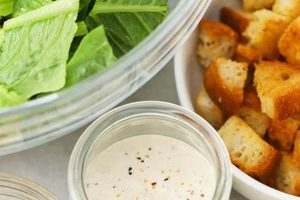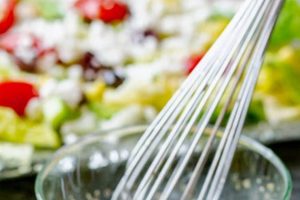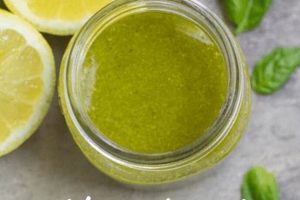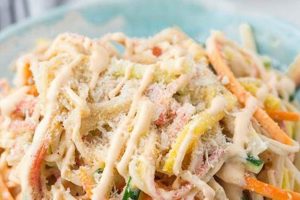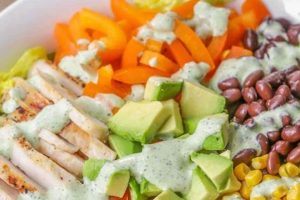A dressing for salads typically featuring the characteristic flavors of buttermilk, herbs (such as dill, chives, and parsley), and spices blended with a reduced-sodium base. This base can involve low-sodium mayonnaise, sour cream, or yogurt. Variations may incorporate additional ingredients like garlic, onion powder, or lemon juice to enhance the flavor profile. An example would be a blend of low-sodium Greek yogurt, fresh herbs, and spices whisked together to create a creamy, flavorful condiment.
Health-conscious individuals often seek flavorful alternatives to traditional condiments that can be high in sodium. A reduced-sodium version allows for enjoyment of a classic flavor profile while supporting dietary restrictions or healthy eating habits. Managing sodium intake is crucial for maintaining healthy blood pressure and overall cardiovascular health. This type of dressing emerged as consumers became more aware of the health implications of excessive sodium consumption and began to demand healthier options.
This exploration will delve into specific ingredients, preparation methods, nutritional information, and potential variations for creating a delicious and healthful condiment. Further discussion will include comparisons with traditional dressings, tips for maximizing flavor, and ideas for incorporating it into various culinary applications.
Tips for Creating Delicious Low-Sodium Ranch Dressing
Creating flavorful dressings with reduced sodium requires careful ingredient selection and preparation. The following tips offer guidance for achieving optimal results.
Tip 1: Fresh Herbs are Key: Dried herbs can sometimes taste bitter. Fresh herbs deliver brighter, more vibrant flavors that compensate for the reduced salt. Generously incorporate fresh dill, chives, parsley, and other preferred herbs.
Tip 2: Embrace Acidity: A splash of lemon juice or white wine vinegar balances the richness and enhances other flavors, making the absence of salt less noticeable.
Tip 3: Explore Low-Sodium Dairy Alternatives: Low-sodium or no-salt-added Greek yogurt or buttermilk provide a creamy base without contributing excessive sodium. Carefully compare nutrition labels to select the lowest sodium options.
Tip 4: Spice It Up: Black pepper, garlic powder, onion powder, and paprika contribute complexity and depth of flavor, diverting attention away from reduced salt.
Tip 5: Taste and Adjust: Incrementally add ingredients, tasting as you go, to ensure the desired balance of flavors is achieved. Tiny adjustments can make a significant difference.
Tip 6: Mindful Ingredient Selection: Some pre-chopped herbs or garlic may contain added sodium. Scrutinize labels to maintain control over sodium content.
Tip 7: Proper Storage: Store homemade dressing in an airtight container in the refrigerator for up to five days, allowing flavors to meld.
By following these tips, one can create a delicious and healthy dressing that satisfies flavor preferences without compromising dietary goals. This approach allows for enjoyment of a beloved condiment while supporting a healthy lifestyle.
The following section provides further information regarding nutritional content and specific recipe variations.
1. Ingredients
Ingredient selection is paramount in formulating a palatable and healthful low-sodium ranch salad dressing. The interplay of components contributes directly to the final flavor profile and nutritional value. Standard ranch dressing often relies on high-sodium ingredients like buttermilk, mayonnaise, and pre-mixed spice blends. A low-sodium approach necessitates careful substitutions and mindful choices.
For instance, traditional buttermilk can be replaced with low-sodium buttermilk or plain low-sodium Greek yogurt thinned with a small amount of milk or water. Mayonnaise, a significant sodium contributor, can be omitted entirely or replaced with a low-sodium alternative. Fresh herbs, such as dill, parsley, chives, and thyme, provide essential flavor and should be prioritized over dried varieties which can often contain added sodium. Spices like garlic powder, onion powder, and black pepper enhance complexity without increasing sodium. Lemon juice or white wine vinegar offer a bright, acidic counterpoint, balancing the richness of the dairy components and further reducing the need for salt.
Careful examination of nutritional labels is essential. Even seemingly innocuous ingredients, like pre-chopped garlic or onion, can harbor hidden sodium. Opting for whole, fresh ingredients whenever possible minimizes the risk of inadvertently introducing excess sodium. This meticulous approach to ingredient selection allows for the creation of a flavorful dressing that aligns with dietary restrictions without sacrificing taste or satisfaction. By understanding the impact of each ingredient on sodium content, individuals can exercise greater control over their dietary intake and enjoy a delicious, healthful condiment.
2. Sodium Content
Sodium content stands as a critical consideration in the formulation of low-sodium ranch salad dressing. Traditional ranch dressings often contain high levels of sodium, primarily from ingredients like buttermilk, mayonnaise, and bottled dressings. Understanding the impact of sodium on health and employing strategies to reduce it without sacrificing flavor are essential components of creating a healthful and enjoyable condiment.
- Health Implications of Sodium
Excessive sodium intake is linked to various health concerns, most notably hypertension, which can increase the risk of cardiovascular disease. Reducing sodium intake is often recommended for individuals managing blood pressure or seeking to maintain overall cardiovascular health. Low-sodium ranch dressing offers a way to enjoy a flavorful condiment while adhering to dietary guidelines for sodium restriction.
- Sodium Sources in Traditional Ranch
Traditional ranch dressings often derive significant sodium content from buttermilk, mayonnaise, and pre-mixed spice blends or seasonings. These ingredients can contribute substantial amounts of sodium per serving, potentially exceeding recommended daily limits. Careful selection of low-sodium alternatives or omitting high-sodium components altogether is essential in crafting a healthier version.
- Strategies for Sodium Reduction
Several techniques can effectively reduce sodium in ranch dressing. Utilizing fresh herbs instead of dried or pre-mixed seasonings, opting for low-sodium or no-salt-added dairy products, and incorporating flavorful spices like black pepper, garlic powder, and onion powder can all contribute to flavor complexity without relying on excess sodium. Careful attention to ingredient labels and prioritizing fresh, whole ingredients further minimizes hidden sources of sodium.
- Balancing Flavor and Sodium Reduction
Reducing sodium does not necessitate sacrificing flavor. The strategic use of fresh herbs, spices, and acidic elements like lemon juice or vinegar can enhance the overall flavor profile, compensating for the absence of salt. Experimentation and careful tasting throughout the preparation process allow for fine-tuning and balancing flavors effectively.
By understanding the role of sodium in both flavor and health, and by employing effective reduction strategies, one can create a low-sodium ranch dressing that is both palatable and beneficial. This allows individuals to enjoy a beloved condiment while prioritizing dietary health and well-being.
3. Preparation Method
Preparation method significantly influences the final quality and flavor profile of low-sodium ranch salad dressing. While the core ingredients contribute the foundational flavors, the method employed to combine them impacts texture, emulsion stability, and overall palatability. A well-executed preparation method maximizes flavor development and ensures a consistent, desirable result.
Traditional ranch dressing often involves whisking or blending ingredients until smooth. This approach remains applicable to low-sodium versions, with slight modifications. Due to the absence of certain emulsifiers sometimes found in higher-sodium ingredients, achieving a stable emulsion requires attention to detail. Slow, gradual incorporation of ingredients, particularly liquids, helps prevent separation. For example, adding low-sodium buttermilk or yogurt drop by drop while whisking constantly helps create a smooth, homogenous mixture, preventing a watery or curdled consistency. Furthermore, allowing the dressing to rest after preparation allows flavors to meld and the emulsion to stabilize further.
Specific techniques can further enhance the final product. Finely chopping fresh herbs maximizes their flavor contribution and ensures even distribution throughout the dressing. Using a mortar and pestle to grind spices before incorporating them can amplify their aroma and taste. If using a blender, brief pulses prevent over-processing, which can lead to a thinner consistency. These nuances in preparation, while seemingly minor, contribute significantly to the overall quality and sensory experience of the low-sodium ranch dressing. Understanding the impact of preparation techniques allows for greater control over the final product and ensures a delicious, healthful outcome.
4. Flavor Profile
Flavor profile represents a critical aspect of low-sodium ranch salad dressing formulation. The challenge lies in replicating the characteristic tangy, herbaceous, and creamy notes of traditional ranch while minimizing sodium content. Flavor perception is complex, involving interactions between taste receptors and aromatic compounds. Sodium, while contributing to overall taste, primarily enhances other flavors. Its reduction necessitates strategic manipulation of remaining ingredients to achieve a balanced and satisfying profile.
Fresh herbs play a crucial role. Dill, parsley, chives, and other herbs provide aromatic complexity and characteristic “green” notes. Their freshness is paramount; dried herbs can impart a bitter taste, especially when salt is reduced. Acidity, from lemon juice or vinegar, provides brightness and balances the richness of dairy components. It also interacts synergistically with herbs, amplifying their flavors. Spices like garlic and onion powder contribute savory depth, further compensating for reduced salt. The choice of low-sodium dairy base also influences flavor. Greek yogurt offers a tangier profile than traditional buttermilk, while low-sodium buttermilk retains a classic ranch flavor. Understanding these interactions allows for tailored flavor development.
Achieving a desirable flavor profile requires careful balancing of ingredients. Over-reliance on any single component can create an unbalanced or one-dimensional taste. For example, excessive acidity can result in a dressing that is too tart, while an overabundance of dill can overpower other flavors. Incremental addition and tasting throughout preparation are essential for achieving a harmonious blend. A successful low-sodium ranch dressing replicates the creamy, tangy, and herbaceous essence of traditional ranch while minimizing sodium. This is achieved not by simply omitting salt, but by understanding the interplay of flavors and strategically utilizing ingredients to create a balanced and enjoyable sensory experience.
5. Health Benefits
Health benefits associated with low-sodium ranch salad dressing recipes primarily stem from reduced sodium intake compared to traditional ranch dressings. Sodium, while essential for bodily functions, can contribute to adverse health outcomes when consumed in excess. Exploring the specific health advantages of lowering sodium intake within the context of this recipe provides valuable insights for individuals seeking healthier dietary choices.
- Blood Pressure Management
Excessive sodium intake is strongly linked to elevated blood pressure, a major risk factor for cardiovascular disease. Consuming a low-sodium ranch dressing contributes to overall sodium reduction, potentially assisting in blood pressure management and promoting cardiovascular health. This is particularly relevant for individuals with hypertension or a family history of heart disease.
- Reduced Risk of Cardiovascular Disease
By helping to maintain healthy blood pressure levels, reduced sodium intake can contribute to a decreased risk of cardiovascular events like heart attack and stroke. Choosing low-sodium options for condiments like ranch dressing represents a proactive step towards long-term cardiovascular well-being.
- Kidney Health
High sodium intake can strain kidney function. Reducing sodium consumption can support kidney health, particularly for individuals with pre-existing kidney conditions. Low-sodium ranch dressing offers a flavorful option for those needing to monitor their sodium intake for kidney health.
- Improved Overall Diet Quality
Opting for low-sodium ranch dressing signifies a broader commitment to healthier eating habits. This choice often accompanies other dietary improvements, such as increased consumption of fresh produce and whole grains, collectively contributing to better overall diet quality and improved health outcomes.
The cumulative impact of these health benefits underscores the significance of choosing low-sodium ranch dressing as part of a balanced diet. By actively managing sodium intake, individuals can make informed choices that positively influence their long-term health and well-being. This conscious approach to dietary choices empowers individuals to enjoy flavorful foods while prioritizing health and wellness.
6. Storage
Proper storage is crucial for maintaining the quality and safety of low-sodium ranch salad dressing. Because reduced-sodium recipes often rely more heavily on fresh ingredients like herbs and dairy, they can be more susceptible to spoilage than their higher-sodium counterparts. Improper storage can lead to bacterial growth, flavor degradation, and undesirable textural changes. Air exposure can cause oxidation, affecting flavor and color. Temperature fluctuations can also contribute to spoilage. Storing the dressing in an airtight container in the refrigerator at a consistent temperature below 40F (4C) inhibits bacterial growth and preserves freshness. For instance, transferring the dressing to a smaller, airtight container minimizes headspace, further reducing oxidation and preserving flavor. Consuming the dressing within five days of preparation is generally recommended for optimal quality.
Practical application of proper storage techniques ensures the dressing retains its desired flavor and texture, maximizing enjoyment and minimizing food waste. Failing to adhere to appropriate storage guidelines can result in a less palatable product and potential health risks. Consider refrigerating the dressing immediately after preparation. Avoid leaving the dressing at room temperature for extended periods, especially in warmer environments. If any signs of spoilage, such as mold growth, off-odors, or changes in texture, are observed, the dressing should be discarded immediately. Careful attention to storage practices safeguards the quality and safety of low-sodium ranch dressing, allowing individuals to enjoy its fresh, flavorful benefits.
Effective storage practices are integral to the overall success of low-sodium ranch salad dressing recipes. Understanding the impact of storage conditions on flavor, texture, and safety empowers individuals to maximize the shelf life and enjoyment of this condiment. This awareness contributes to a more satisfying culinary experience and minimizes potential food waste, reinforcing the practical significance of proper storage techniques in the context of low-sodium culinary preparations.
7. Variations
Variations within low-sodium ranch salad dressing recipes offer opportunities to personalize flavor profiles while adhering to dietary restrictions. Adaptability is crucial for long-term adherence to any dietary modification. Exploring variations allows individuals to discover preferred flavor combinations, preventing monotony and ensuring continued enjoyment of healthful choices. The core principles of sodium reduction remain constant, but variations introduce flexibility and creativity within those boundaries.
- Herb and Spice Combinations
A foundational element of ranch dressing flavor derives from the blend of herbs and spices. Traditional recipes often feature dill, parsley, chives, and garlic. Variations can incorporate other herbs like cilantro, mint, or tarragon, offering unique flavor profiles. Spice variations can include smoked paprika, cumin, or cayenne pepper for added depth and complexity. These adjustments cater to individual preferences and allow for exploration of diverse flavor combinations without increasing sodium content. For example, a Southwestern-inspired variation might incorporate cilantro and cumin, while a Mediterranean version could feature mint and oregano.
- Dairy Base Modifications
The choice of dairy base significantly influences the overall flavor and texture. While low-sodium buttermilk or Greek yogurt are common choices, variations can include low-sodium sour cream or cashew cream for a vegan option. Each dairy alternative introduces subtle flavor nuances and textural differences. Cashew cream, for instance, offers a richer, creamier texture compared to yogurt, while sour cream provides a tangier profile. Understanding these differences allows for customization based on individual preferences and dietary needs.
- Inclusion of Additional Flavoring Agents
Incorporating additional flavoring agents allows for further customization and complexity. Roasted garlic, for example, imparts a deeper, sweeter garlic flavor compared to garlic powder. A small amount of finely grated lemon zest can enhance brightness and citrus notes. These additions introduce subtle yet impactful flavor nuances, expanding the potential flavor profiles within the low-sodium framework. A touch of Dijon mustard can add a subtle tang, while a splash of Worcestershire sauce (ensure low sodium) can provide umami depth.
- Texture Adjustments
Texture variations can further enhance the sensory experience. Blending the dressing until completely smooth creates a homogenous, creamy texture, while leaving some herbs coarsely chopped provides textural contrast. Adding a small amount of finely diced cucumber or bell pepper offers a crisp, refreshing element. These textural adjustments contribute to a more dynamic and engaging culinary experience, demonstrating that reducing sodium does not necessitate sacrificing enjoyment or satisfaction.
These variations highlight the adaptability of low-sodium ranch dressing recipes. By exploring different ingredient combinations and preparation techniques, individuals can create customized versions that align with both their flavor preferences and dietary goals. This flexibility promotes long-term adherence to a reduced-sodium diet by ensuring continued enjoyment and preventing dietary monotony. The exploration of variations underscores the potential for creativity and personalization within the realm of healthful eating, demonstrating that dietary restrictions can be embraced without compromising flavor or satisfaction.
Frequently Asked Questions
This section addresses common inquiries regarding low-sodium ranch salad dressing recipes, providing clear and concise information to facilitate informed culinary choices.
Question 1: How does reducing sodium impact the flavor of ranch dressing?
Sodium enhances flavors, so its reduction necessitates careful balancing of other ingredients. Fresh herbs, spices, and acidity compensate for the absence of salt, creating a flavorful profile despite reduced sodium content.
Question 2: What are suitable low-sodium dairy alternatives for ranch dressing?
Low-sodium or no-salt-added buttermilk and plain low-sodium Greek yogurt serve as excellent bases. Low-sodium sour cream or unsweetened cashew cream (for vegan options) also provide viable alternatives.
Question 3: How can one ensure a smooth and stable emulsion in low-sodium ranch dressing?
Gradual incorporation of liquids while whisking constantly promotes a stable emulsion. Allowing the dressing to rest after preparation further enhances stability.
Question 4: What are effective strategies for maximizing flavor in low-sodium ranch dressing?
Prioritizing fresh herbs over dried, incorporating flavorful spices like garlic and onion powder, and balancing acidity with lemon juice or vinegar contribute significantly to flavor enhancement.
Question 5: How should low-sodium ranch dressing be stored to maintain optimal quality?
Refrigeration in an airtight container below 40F (4C) is crucial. Minimizing headspace and consuming the dressing within five days of preparation further preserves freshness.
Question 6: Are there specific health risks associated with consuming traditional, high-sodium ranch dressings?
Regular consumption of high-sodium dressings can contribute to elevated blood pressure and increased risk of cardiovascular issues, especially for individuals sensitive to sodium.
Understanding the nuances of sodium reduction and its impact on flavor and health enables informed decision-making. Prioritizing fresh ingredients, proper storage, and balanced flavor profiles ensures a satisfying and healthful culinary experience.
The subsequent section provides a sample recipe demonstrating these principles in practice.
Conclusion
Low-sodium ranch salad dressing recipes offer a viable path towards healthier eating without compromising flavor. Exploration of ingredient selection, preparation methods, flavor balancing, health benefits, and storage practices reveals the potential for creating delicious and healthful condiments. Careful consideration of sodium content, coupled with strategic utilization of fresh herbs, spices, and low-sodium dairy alternatives, allows for replication of the characteristic ranch flavor profile while minimizing sodium intake. Understanding the impact of sodium on health underscores the significance of these culinary adaptations.
Dietary modifications need not equate to culinary sacrifice. Low-sodium ranch dressing exemplifies how informed choices and creative culinary techniques can transform dietary restrictions into opportunities for flavorful exploration. This approach empowers individuals to prioritize health and well-being without relinquishing enjoyment of beloved flavors. Continued exploration and experimentation within the realm of low-sodium cuisine promise further culinary discoveries and contribute to a broader understanding of the interplay between flavor, health, and culinary ingenuity.


